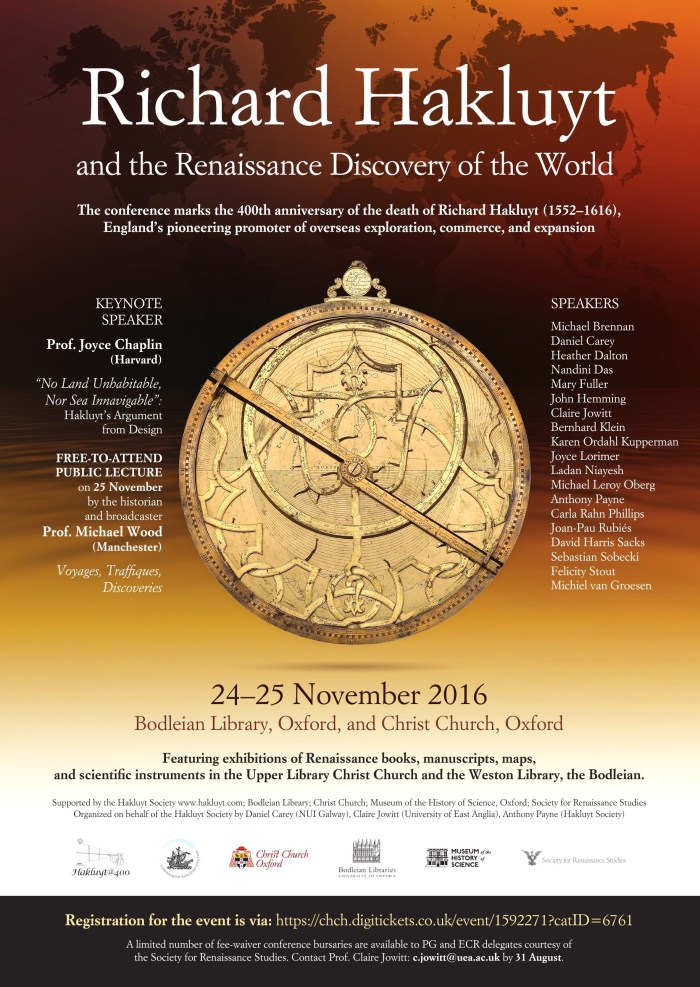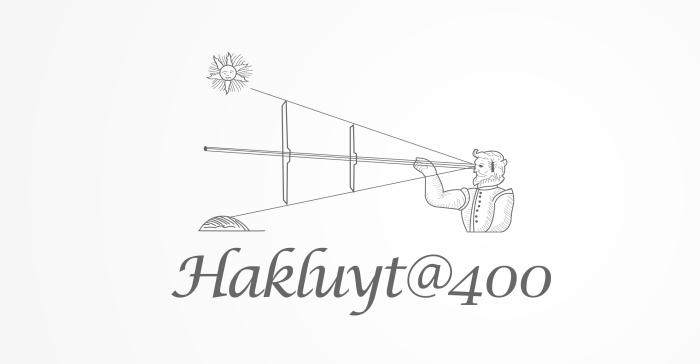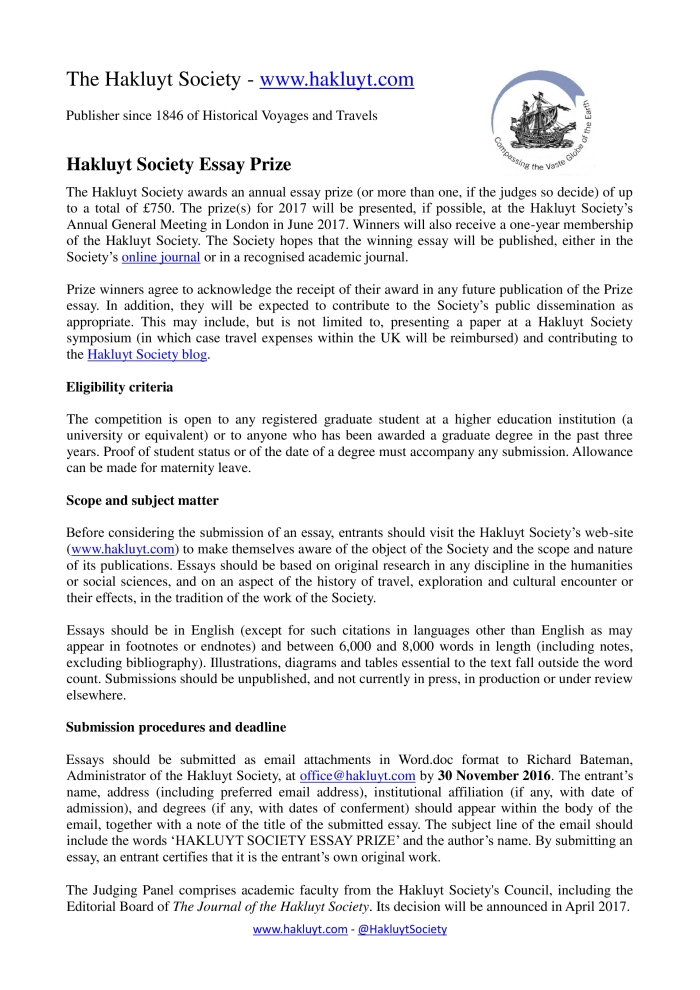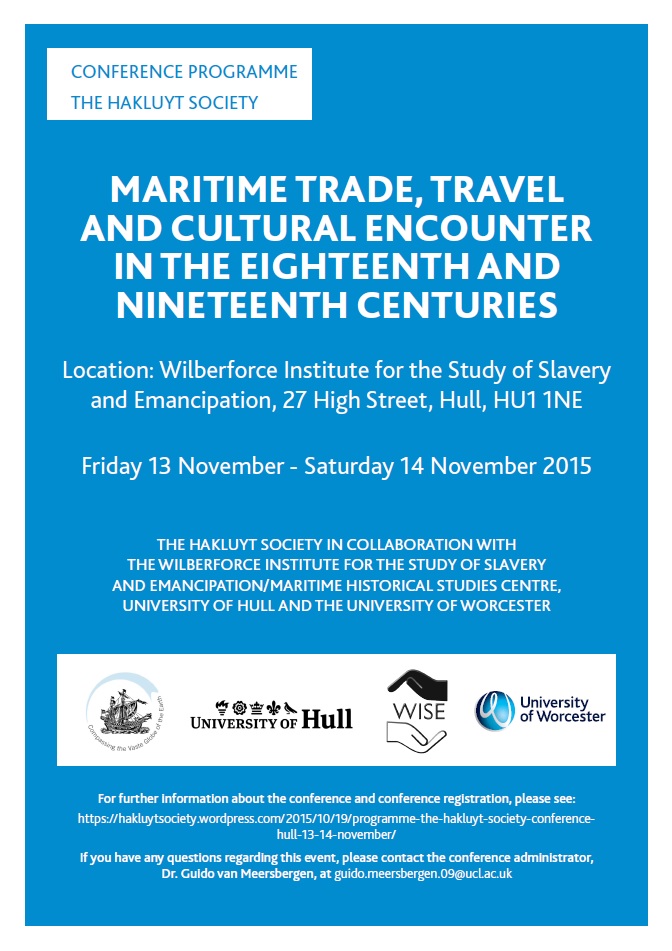This year is the 400th anniversary of the death of Richard Hakluyt (1552-1616) and the Hakluyt Society will mark this with an exciting programme of events in Oxford and at Hakluyt’s parish of Wetheringsett in Suffolk. Centrepiece of the Hakluyt@400 events will be the two-day international conference Richard Hakluyt and the Renaissance Discovery of the World, taking place in Oxford on 24-25 November (book your tickets here)
Two free exhibitions will accompany this interdisciplinary conference, both to be launched in October 2016: Hakluyt and Geography in Oxford 1550–1650 at Christ Church, Oxford, and The World in a Book: Hakluyt and Renaissance Discovery, at the Bodleian Library, Oxford. In addition, on Sunday 27 November there will be a commemorative service in All Saints Church, Wetheringsett, Suffolk. Read on for a detailed overview of events!
– Join the Hakluyt Society on www.hakluyt.com –
Exhibitions
The two free exhibitions in Oxford will run from October to December 2016. On Friday 14 October, Hakluyt and Geography in Oxford 1550–1650 will be launched at Christ Church, Hakluyt’s old college, with a symposium on Renaissance scientific instruments and a reception. In November, events at Christ Church will include workshops on scientific instruments from the Christ Church collection by Dr Allan Chapman and Dr Stephen Johnston.
On Friday 28 October, The World in a Book: Hakluyt and Renaissance Discovery will be launched with a lecture (5:30pm) by William Poole (New College), introducing the books which heralded an era of exploration, discovery, and imperial expansion. The lecture opens a display at the Bodleian’s Weston Library of the works and collections of Richard Hakluyt. One of the greatest treasures of the library, the Codex Mendoza, once owned by Hakluyt, will be included in this exhibition.
Commemorative Service
At 10.30 a.m. on Sunday 27 November, there will be a commemorative service in All Saints Church, Wetheringsett, Suffolk, IP14 5PP, Hakluyt’s parish, which will be led by the Bishop of St Edmundsbury and Ipswich, with the dedication of a stone plaque in memory of Richard Hakluyt. This will be followed by a buffet lunch in the Village Hall with a programme of music and readings. There will be an opportunity for small groups of Hakluyt Society members to visit the surviving part of Hakluyt’s former rectory.
Members who wish to be present at Wetheringsett are asked to contact the Society (office@hakluyt.com) as early as possible to assist the planning of the local organisers.
Conference
The two-day conference, Richard Hakluyt and the Renaissance Discovery of the World, takes place on 24 November at the Bodleian Library, and on 25 November at Christ Church, Oxford. Twenty renowned experts on Hakluyt and early modern travel and exploration have accepted an invitation to speak at the conference. The keynote lecture on 24 November, “No Land Unhabitable, Nor Sea Innavigable“: Hakluyt’s Argument from Design will be delivered by Professor Joyce Chaplin (Harvard University). At the conclusion of the event on 25 November, a free to attend public lecture, Voyages, Traffiques, Discoveries, will be given by the well-known broadcaster and historian Professor Michael Wood (more info below).

Full line-up
Keynote speakers
Professor Joyce Chaplin – Harvard University
Professor Michael Wood – The University of Manchester
Speakers
Professor Michael Brennan – University of Leeds
Professor Daniel Carey (organiser) – NUI Galway
Dr Heather Dalton – University of Melbourne
Professor Nandini Das – University of Liverpool
Professor Mary Fuller – MIT
Dr John Hemming – Hakluyt Society
Professor Claire Jowitt (organiser) – University of East Anglia
Professor Bernhard Klein – University of Kent
Professor Karen Ordahl Kupperman – New York University
Professor Emerita Joyce Lorimer – Tri University
Professor Ladan Niayesh – Université Paris Diderot
Professor Michael Leroy Oberg – SUNY-Geneseo
Anthony Payne (organiser) – Hakluyt Society
Professor emerita Carla Rahn Phillips – University of Minnesota
Professor Joan-Pau Rubiés – Universitat Pompeu Fabra
Professor Emeritus David Harris Sacks – Reed College
Professor Sebastian Sobecki – University of Groningen
Dr Felicity Stout – The University of Sheffield
Professor Michiel van Groesen – Leiden University
Registration and Bursaries
Registration for this two-day event costs £100 per person or £60 for members of the Hakluyt Society and for postgraduates. The fee includes coffee/tea, lunches, and a reception at Christ Church on the Thursday evening. Space is limited and early registration is advised.
A number of fee-waiver postgraduate bursaries are available, due to an award from the Society for Renaissance Studies. If you wish to apply for a bursary, please contact Professor Claire Jowitt (c.jowitt@uea.ac.uk) by 31 August 2016.
All postgraduates who register to attend the conference are entitled to a 50% reduction in membership of the Hakluyt Society for one calendar year (to £15.00). To join using this offer, please see http://www.hakluyt.com/hak-soc-membership.htm and also send confirmation of your registration to attend the conference to office@hakluyt.com.
To book your place, click here.
@HakluytSociety – Become a member at www.hakluyt.com – #Hakluyt400













